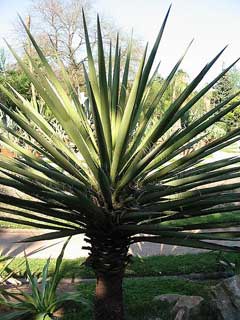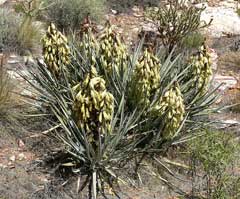 |
|
|
 |
| commons.wikimedia.org/wiki/User:Stan_Shebs |
Translate this page:
Summary
Bloom Color: White. Main Bloom Time: Early summer, Early spring, Late summer, Late spring, Mid summer, Mid spring. Form: Rounded.
Physical Characteristics

 Yucca_baccata is an evergreen Shrub growing to 0.9 m (3ft) at a slow rate.
Yucca_baccata is an evergreen Shrub growing to 0.9 m (3ft) at a slow rate.
See above for USDA hardiness. It is hardy to UK zone 7. It is in leaf all year, in flower in August. The species is hermaphrodite (has both male and female organs) and is pollinated by Hand.
Suitable for: light (sandy), medium (loamy) and heavy (clay) soils, prefers well-drained soil and can grow in nutritionally poor soil. Suitable pH: mildly acid, neutral and basic (mildly alkaline) soils. It cannot grow in the shade. It prefers dry or moist soil and can tolerate drought. The plant can tolerates strong winds but not maritime exposure.
UK Hardiness Map
US Hardiness Map
Synonyms
Sarcoyucca baccata (Torr.) Linding
Plant Habitats
Edible Uses
Fully ripe fruit - raw, cooked or dried for winter use[1, 2, 3, 62, 92, 94, 257]. A staple food for several native North American Indian tribes, the fruits are large, fleshy, sweet and palatable[85, 92, 95, 183]. The ovoid fruit is about 17cm long and 7cm wide[200]. Considered to be a luxury by the native North American Indians[207], the fruits were often baked in ovens[216]. The cooked fruit can be formed into cakes and then dried for later use[257]. Large quantities of the fruit has caused diarrhoea in people who are not used to it[85]. The dried fruit can be dissolved in water to make a drink[257]. Flower buds - cooked[2, 62, 95, 183]. A soapy taste[85]. The older flowers are best[85], they are rich in sugar[94]. The flowers, harvested before the summer rains (which turn them bitter), have been used as a vegetable[257]. Flowering stems - cooked[257]. Harvested before the flowers open then roasted[257]. Seed - cooked. It can be roasted and then ground into a powder and boiled[62, 85]. The tender crowns of the plants have been roasted and eaten in times of food shortage[257]. The young leaves have been cooked as a flavouring in soups[257].
References More on Edible Uses
Medicinal Uses
Plants For A Future can not take any responsibility for any adverse effects from the use of plants. Always seek advice from a professional before using a plant medicinally.
An infusion of the pulverized leaves has been used as an antiemetic to prevent vomiting[257]. The fruits have been eaten raw as a laxative[257].
References More on Medicinal Uses
The Bookshop: Edible Plant Books
Our Latest books on Perennial Plants For Food Forests and Permaculture Gardens in paperback or digital formats.

Edible Tropical Plants
Food Forest Plants for Hotter Conditions: 250+ Plants For Tropical Food Forests & Permaculture Gardens.
More

Edible Temperate Plants
Plants for Your Food Forest: 500 Plants for Temperate Food Forests & Permaculture Gardens.
More

More Books
PFAF have eight books available in paperback and digital formats. Browse the shop for more information.
Shop Now
Other Uses
A fibre obtained from the leaves is used for making ropes, baskets and mats[21, 46, 57, 85, 92, 94, 95]. The fibre can be braided into a good quality rope[257]. The leaves can be reduced into fibre and then made into cloth[257]. To obtain the fibre, the terminal spine and a section of the back of the leaf are removed and pounded to free the fibre from the fleshy portion of the leaf[257]. Another method of obtaining the fibre was to fold the leaves into sections about 10cm long. The leaves were then boiled with a small quantity of cedar ashes. When sufficiently cooked, the leaves were placed in a bowl or basket and cooled, then youths and young women would peel off the epidermis and chew the leaves, starting at one end and finishing at the other. After chewing the leaves, the fibres were separated, straightened out and hung to dry. When required for weaving, they would first be soaked in water to soften them[257]. The whole leaf is sometimes split into sections and then tied together by square knots to make a rope[92, 257]. The leaf can be used as a paint brush[92]. Leaf slivers are used, the end being pounded to reveal the fibres[257]. The leaves have also been used to make small brushes for pottery decoration[257]. The leaf is used in basket making[216, 257]. Small roots have been used in making baskets[257]. They have been used to produce a red pattern in baskets[257]. The leaves can be split and then woven into mats[257]. The leaves can be split and used as a temporary string[257]. The leaf fibre has been braided into ropes[257]. The terminal spines have been used as needles[257]. The dried leaves have been boiled with gum, hardened, ground into a powder then mixed with water and used to make baskets waterproof[257]. The roots are rich in saponins and can be used crushed and then soaked in water to release the suds for use as a soap[21, 85, 95, 216, 257]. It makes a good hair wash[85, 94, 257] and can also be used on the body and for washing clothes[257]. A soap can also be obtained from the leaves and stems[257].
Special Uses
References More on Other Uses
Cultivation details
Landscape Uses:Border, Massing, Specimen. Thrives in any soil but prefers a sandy loam and full exposure to the south[11]. Plants are hardier when grown on poor sandy soils[200]. Prefers a hot dry position[166], disliking heavy rain[3]. Established plants are very drought resistant[11]. Only hardy in the milder areas of Britain[3, 200]. Another report says that plants are hardy to at least -30°c[164]. A plant at Kew (1992) has survived the last 3 winters outdoors[K]. This plant is still thriving in 1999, though it has not grown much and has not flowered[K]. Another plant is thriving in an open sunny position at Cambridge Botanical Gardens and must have experienced temperatures of at least -10°c, probably somewhat lower[K]. In the plants native environment, its flowers can only be pollinated by a certain species of moth. This moth cannot live in Britain and, if fruit and seed is required, hand pollination is necessary. This can be quite easily and successfully done using something like a small paint brush. Individual crowns are monocarpic, dying after flowering[233]. However, the crown will usually produce a number of sideshoots before it dies and these will grow on to flower in later years[233]. Plants in this genus are notably resistant to honey fungus[200]. Members of this genus seem to be immune to the predations of rabbits[233]. Special Features:
North American native, Fragrant flowers, Attractive flowers or blooms. For polyculture design as well as the above-ground architecture (form - tree, shrub etc. and size shown above) information on the habit and root pattern is also useful and given here if available. The plant growth habit is multistemmed with multiple stems from the crown [1-2]. An evergreen. The root pattern is a tap root similar to a carrot going directly down [1-2].
References Carbon Farming Information and Carbon Sequestration Information
Temperature Converter
Type a value in the Celsius field to convert the value to Fahrenheit:
Fahrenheit:
The PFAF Bookshop
Plants For A Future have a number of books available in paperback and digital form. Book titles include Edible Plants, Edible Perennials, Edible Trees,Edible Shrubs, Woodland Gardening, and Temperate Food Forest Plants. Our new book is Food Forest Plants For Hotter Conditions (Tropical and Sub-Tropical).
Shop Now
Plant Propagation
Seed - sow spring in a greenhouse. Pre-soaking the seed for 24 hours in warm water may reduce the germination time. It usually germinates within 1 - 12 months if kept at a temperature of 20°c. Prick out the seedlings into individual pots when they are large enough to handle and grow them on in the greenhouse or cold frame for at least their first two winters. Plant them out into their permanent positions in early summer and consider giving them some winter protection for at least their first winter outdoors - a simple pane of glass is usually sufficient[K]. Seed is not produced in Britain unless the flowers are hand pollinated. Root cuttings in late winter or early spring. Lift in April/May and remove small buds from base of stem and rhizomes. Dip in dry wood ashes to stop any bleeding and plant in a sandy soil in pots in a greenhouse until established[78]. Division of suckers in late spring[3]. Larger divisions can be planted out direct into their permanent positions. We have found that it is best to pot up smaller divisions and grow them on in light shade in a greenhouse or cold frame until they are growing away well. Plant them out in the following spring.
Other Names
If available other names are mentioned here
Spanish bayonet, Datil, Palmilla ancha, Banana yucca,
Native Range
NORTHERN AMERICA: United States, Colorado (southwest), New Mexico, Texas (southwest), Arizona, California (southeast), Nevada (south), Utah (south), Mexico, Chihuahua, Sonora,
Weed Potential
Right plant wrong place. We are currently updating this section.
Please note that a plant may be invasive in one area but may not in your area so it’s worth checking.
Conservation Status
IUCN Red List of Threatened Plants Status :

Growth: S = slow M = medium F = fast. Soil: L = light (sandy) M = medium H = heavy (clay). pH: A = acid N = neutral B = basic (alkaline). Shade: F = full shade S = semi-shade N = no shade. Moisture: D = dry M = Moist We = wet Wa = water.
Expert comment
Author
Torr.
Botanical References
200235
Links / References
For a list of references used on this page please go here
Readers comment
© 2010, Plants For A Future. Plants For A Future is a charitable company limited by guarantee, registered in England and Wales. Charity No. 1057719, Company No. 3204567.